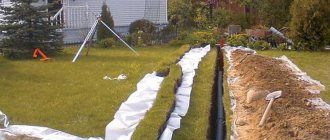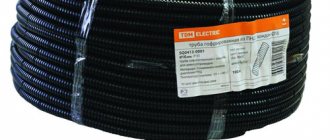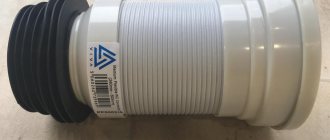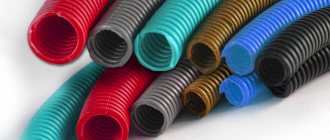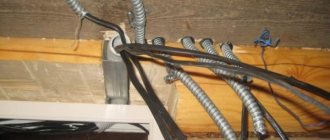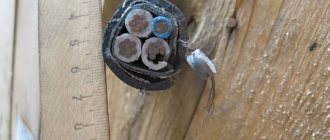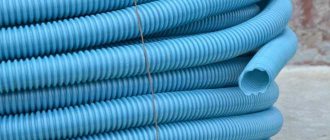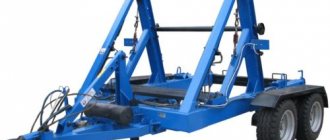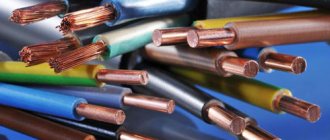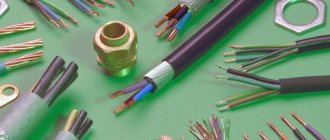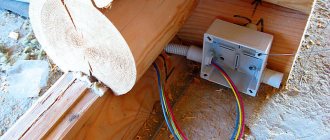Cable corrugation is necessary protection for wiring for various purposes. Depending on the number of wires to be pulled, as well as the state of the environment, manufacturers suggest using corrugated hoses that are appropriate in material and thickness. This can provide protection from external weather, temperature, ultraviolet influences or other random factors. Next, we’ll look at how to correctly select a corrugated cable, and what installation features there are for it.
The cable is located inside the corrugation Source rackcdn.com
Why do you need corrugation?
Corrugation is a corrosion-resistant, hollow special ribbed pipe used for laying wires and cables in various environments and conditions. Depending on the type, it is not exposed to external factors, water, etc. Special corrugated pipes are used for laying various wires and cables:
- underground (to provide a hard shell and protection from groundwater, rotting, damage by animals and rodents);
- in wooden, frame and other combustible walls or laid under fire-hazardous finishing materials such as lining, wooden panels and others (for protection against fire and unintentional damage to the cable);
- under the floor covering (to protect against compression by concrete or other damage);
- outside buildings (to protect against illegal actions of third parties and atmospheric phenomena, including exposure to ultraviolet radiation and high temperatures in the summer).
Important! Fireproof types of corrugation, when a fire occurs, begin to release special substances that prevent the spread of fire, as a result of which the fire quickly dies out.
Protected metal corrugated hose Source tepluydim.com.ua
Thanks to proper work with corrugated pipes, when it becomes necessary to replace the wires with new ones, this can be done without dismantling the already installed corrugated hoses. A special broach is used for this.
How to choose pipes for cable laying
In order to correctly select HDPE pipes for electrical wiring, it is necessary to take into account generally accepted values, as well as the number of wires laid in them. To accurately determine the diameter of a technical HDPE pipe for cables of different sections, use the table:
Calculation of the number of cables in a pipe
| Wire cross-section (sq.mm) | HDPE sleeve diameter – mm. | Number of cables to be passed – pieces. |
| 95 or more | 63/63 | 3/2 |
| 70 | 63/53/63 | 3/2/4 |
| 50 | 50/50/63/63 | 3/2/5/4 |
| 35 | 50/40/63/50 | 3/2/5/4 |
| 25 | 40/32/50/50 | 3/2/5/4 |
| 16 | 32/32/40/40 | 3/2/5/4 |
| 10 | 32/25/40/32 | 3/2/5/4 |
| 6 | 25/20/32/32 | 3/2/5/4 |
| 4 | 20/20/25/25 | 3/2/5/4 |
| 2,5 | 16/16/25/20 | 3/2/5/4 |
| 1,5 | 16/16/20/20 | 3/2/5/4 |
Thus, you need to understand that the number of supposed cores increases the flow area of the hose.
Kinds
Corrugations for wires are available in several dozen types. The articles of this special product differ in color, material of manufacture, diameter, load-bearing capacity, and wall thickness. Let's look at the types of corrugated pipes:
By material
- Polyvinyl chloride (PVC). Used as non-flammable and inexpensive cable protection products that must be located away from exposure to sunlight, water and ultraviolet radiation.
- Metal (metal hoses). Protect from mechanical damage, fires, corrosive and other active substances.
- Polyethylene, polypropylene (PPR). They can be intended for installation under conditions of high (HPE) or low (HDPE) pressure, withstand temperature influences from – 40 ° C to + 45 ° C, as well as exposure to acids, alkalis, ultraviolet rays and oils (PPR pipes are self-extinguishing and usually are painted gray during manufacturing, HDPE – orange or black).
Polyethylene corrugation Source elektro-svitidla.com
In terms of resistance to external influences
- Lightweight (wall thickness up to 320 N/5 cm², flexible, cannot withstand heavy loads) are laid in ceiling and wall plasterboard structures.
- Medium ones (wall thickness up to 750 N/5 cm²) can be placed in the grooves of room walls.
- Heavy (wall thickness up to 1250 N/5 cm², are inflexible) can withstand installation in concrete screeds, withstand exposure to moisture, dust and dirt.
- Reinforced super-heavy (the thickness of the walls of the metal corrugation for electrical wiring is more than 1250 N/5 cm², it consists of metal wires twisted in a spiral, covered with a plastic sheath) intended for installation outdoors or underground.
By number of layers
- Single-layer (may have different thicknesses).
- Double-layer (have two walls at once).
Metal corrugation, in turn, is divided into several subspecies. It can be made from stainless or galvanized steel; plastic or polymer material is used as a coating. Metal-polymer corrugated hose has the best user characteristics, as it maximally protects wires from water and dust.
This is interesting! Typically, red, blue and black polyethylene corrugated pipes are used for outdoor use and general purpose circuits, respectively, white ones are found in places where the Internet and electrical networks are laid, green ones are used for telephony, although this rule is not required to be observed.
See also: Catalog of companies that specialize in electrical work of any complexity
The outer diameter of corrugated cable products can range from 16 mm to 87.5 mm, the inner diameter - from 5 mm to 78 mm. Also, the design of some corrugated pipes includes a probe that helps pull flexible wires through the sleeve.
According to GOST R IEC 61386, several types of corrugated hoses are distinguished: according to the degree of spread of the combustion process, and according to protection against corrosion. According to the rules of GOST 14254-2015, the degree of protection of corrugated pipes from penetration and exposure to solid particles and/or water is indicated according to the IP index. Corrugated highways are also divided into several types according to the temperature range at which they can be operated. When choosing a specific type of corrugation, a specialist must be guided by information about the use and location of the wiring being laid.
Laying in grooves Source uk-parkovaya.ru
For example, outdoors it is imperative to use a protected reinforced corrugated pipe, which resists the effects of mechanical, natural, and temperature factors and has an IP rating corresponding to the expected load.
Size
The thickness of the corrugated cable determines the number and thickness of wires that can be laid through such a protective sleeve. When a corrugated pipe is sold, it is marked in which the first number indicates the outer diameter, the second - the wall thickness. The diameter of the cable corrugation is indicated in the table:
This is how the thickness of the corrugation is determined (table, part 1) Source infocable.by
This is how the thickness of the corrugation is determined (table, part 2) Source infocable.by
Polyethylene and polypropylene
If you are looking for which corrugation is best to choose for indoor or outdoor use, we recommend paying attention to polyethylene or polypropylene samples. Their properties and price characteristics are approximately the same. Such protective channels are not sensitive to sunlight, temperature changes and high humidity. They feel great in both cold and hot conditions.
The HDPE hose is very flexible and can withstand oils and solvents. High-pressure material is in demand for laying in walls made of non-combustible materials, for example, in a brick or concrete structure.
Polypropylene channels are used when working with a monolithic base. Samples made of polyamide are also known. This material provides excellent waterproofing.
Installation
Now that you know why corrugation is needed in electrical wiring, it is worth considering the algorithm for the correct installation of corrugated hoses.
Corrugated pipes must be laid according to certain rules Source tehznatok.com
Thus, when laying cables and wires externally, special plastic clips and clamp-dowels are used for fastening, which are attached every 20-30 cm. In this case, ordinary dowels or self-tapping screws are used additionally, but in such a way as not to damage the integrity of the outer layer of the corrugation. If the installation is carried out in grooves, plastic ties (clamps) or tin strips secured in the middle with nails are also used.
To correctly install corrugated pipes with wiring, the following rules must be observed:
- absence of sharp turns, the angle of which is less than 90 ° (for a track with four turns, the length can reach a maximum of 25 meters);
- if low-current cables are located near the route being laid, a distance of at least 20 cm should be maintained;
- if the structure in which the wiring needs to be installed is monolithic, the corrugated hose must be placed before concrete is poured, and the wires should be pulled after the mortar has hardened;
- the distance between two adjacent turns of the electric corrugation is at least 4-5 meters;
Hairstyles for short hair
For some reason, girls with short hair think that such a perm will not suit them. However, this is not at all true.
Alternating curls and corrugations
Classic curls combined with structured strands look incredible on short hair.
Loose tail
This hairstyle allows you to create a careless look, which is at the peak of popularity today.
From roots to ends
First of all, fashionistas with thin hair should take a closer look at this style. Just a little styling and you're done!
Video description
A life hack for marking a route is shown in this video:
- if it is impossible to make the required distance between the turns of the electrical route, a distribution board (box) and an inspection hatch should be installed instead;
- to install hidden wiring in the walls, grooves of the required depth are first hollowed out (it must correspond to the diameter of the corrugated pipe);
- between two adjacent corrugated hoses there should not be less than 20 cm; if intersection is necessary, a right angle should always be maintained.
It is important! To correctly and securely fasten the corrugation, you need to lean it against a special, pre-fixed clip and press until a characteristic click is heard.
Connections between two different pieces of corrugation are made using special couplings, turn signals or tees. If it is necessary to protect the wires from water, special plugs with small slots are put on the corrugation.
To install corrugations for electrical wiring with a broach, that is, in a closed way, you need:
- Measure and cut the required length of the corrugated sleeve and make sure that it is tensioned.
- Secure the broach so that it does not go deep into the pipe.
Easy hairstyles
There are different options for styling with corrugation, and you can do many of them yourself. One popular example is the tail. Stylists suggest using crimps on all hair, gathered in a ponytail or styling several strands in a similar manner. No less attractive is the corrugated bun, which looks fashionably casual and is formed using a hair tie and a pair of hairpins. The “malvina” hairstyle, which removes strands from the forehead and is quite suitable for styling the hair of a young fashionista, does not require special skills to perform. Loose hair with an original straight or zigzag parting, as well as hair with wavy bangs laid on its side, look gorgeous.
Features of the rules for standardization of corrugated pipes
As stated earlier, corrugated pipes are standardized according to the rules for laying pipe systems for cables GOST R IEC 61386.1-2014. The document specifies the conditions for constructing such systems and the rules for correctly connecting elements to each other. The corrugated pipes under consideration must undergo testing in compliance with parameters, including a certain ambient temperature.
This is what a cable corrugation looks like Source proumnyjdom.ru
Each variety of these materials is assigned a classification code, marking according to the degree of resistance to compression, fracture, impact, bending, tension, suspended load, exposure to permissible ambient temperature, electrical characteristics, degree of protection from external influences, degree of protection from fire and combustion. The level of possibility of penetration of water, solid particles, including dust, dirt and others is also regulated.
Degrees of protection, designated as IP, are specified in the rules of GOST 14254-2015, which correspond to the international standard IEC 60529:2013. These rules clearly outline the basis for certification of various protected materials, which are marked by indicating the degree of protection from external influences. The composition of the IP code is described in detail with the decoding of each letter and number from the cipher, including auxiliary characters.
